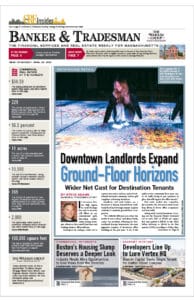
The average tenant allowance in downtown Boston in the third quarter was, on a per-square-foot basis, the highest recorded in history. Photo by James Sanna | Banker & Tradesman Staff
If you didn’t know better, Boston’s office market might seem like it’s humming along in a strong economy.
Construction cranes dotting the skyline include high-profile mixed-use projects like Hines’ South Station Tower, which includes a class A office component, and 10 World Trade, a distinctive life science and office project in the Seaport by Boston Global Investors.
One Congress, a 1 million-square-foot office tower, now wears a well-lit State Street marquee across the top reflecting the financial service giant’s new headquarters. But the financial services firm’s old digs, One Lincoln, doesn’t sit unoccupied, as that tower now wears the lit nameplate of a new marquee tenant, private equity firm HarbourVest Partners.
Despite all the glitzy names lighting up the skyline, there is frost in the Greater Boston office environment like many other U.S. cities: The vacancy rate for class A office product in Boston sits at nearly 19 percent, while that for class B product now tops 27 percent, according to brokerage Colliers.
Office leasing velocity declined 17.5 percent between the second and third quarters, according to Avison Young data. The region’s 20.6 percent availability rate in the office sector is the highest seen since the Great Recession. It’s also unlikely the region’s office cooldown has bottomed out.
“We’re not there yet. I think rents are still going to decrease into next year,” said Tucker White, Avison Young’s Boston manager of market intelligence as well as the firm’s U.S. life science lead of market intelligence. “In terms of leasing, there’s still a ways to go before it bottoms out. In terms of investment sales, you’re starting to see the baseline being set. I think 12 months from now, we’ll look back on the second half of the 2023 when it really started. That’s when we started getting some transactions.”
There are 12 million square feet of active office leases in downtown Boston set to expire through the end of 2025. That is expected to put further downward pressure on rent terms, as companies are increasingly opting for less space reflecting more streamlined operations and hybrid work models.
Tenant Allowances Hit Highs
While much activity in the Boston office environment follows a so-called “flight to quality” trend – companies opting for nicer digs in newer product like Winthrop Center or One Congress – the Avison Young report notes much of pending lease expirations are in class A office buildings.
While that’s not exactly music to the ears of developers and landlords, it does present an opportunity for growth for companies that might have previously found Boston to have a significantly higher barrier to entry relative to other major U.S. cities.
“2024 really could be the year of the tenant,” said Jeffrey Myers, a research director for Colliers. “Tenants are really in a great position to get a good deal, and, because I don’t think the market has bottomed out yet, next year could be even more favorable.”
Along with a litany of options, both on the direct lease and sublease market, landlords are courting tenants with more concessions as they increasingly move toward boosting occupancy rates at the expense of rent, White added.
The $109-per-square-foot average tenant improvement allowance offered on a normalized 10-year basis in the third quarter was the highest seen in history, according to the Avison Young report. The 7.4 months of free rent seen on average was also at the higher end of offerings.
There are still some reasons to be optimistic about the region’s office sector heading into the year: Lego’s decision to move its Americas headquarters from Connecticut to a 100,000-square-foot office at the new 1001 Boylston St. in Back Bay is a sign there is still plenty of interest from outside the city to be here, experts say.
On the default front, there is national concern office owners are facing a significant looming credit crunch due to exposure to commercial mortgage-backed securities, as reported last week by the Wall Street Journal. The rate of delinquent office CMBS loans tripled this year, per Trepp data cited in the newspaper’s report.
That’s less of a concern in Boston, where less than 10 percent of office inventory is backed by CMBS loans, White said. Instead, local developers here tend to turn to regional banks, instead.
“Where the pain is going to be felt is more of those regional banks, so we’ll see what happens there,” he said. “Most investors still look at Boston as a strong gateway market.”
Roadblocks on the Return to Office
Where further pain is likely to be felt, however, is from MBTA reliability.
While companies continue to encourage employees’ return to the office, the regional transit system isn’t exactly helping get employees efficiently – or reliably – to work. The notorious slow zones on the subway system while the transit agency works on repairs aren’t likely to be fully eliminated on every line until the end of 2024.
Commuter rail ridership is now over 90 percent of its pre-pandemic level, the T announced this month, while and bus ridership is now 71 percent of its pre-pandemic level, per MBTA data used in the Avison Young report. But subway ridership is only at 53 percent. Not only does that have an impact on occupancy within an office, but it can also certainly impact valuations of projects built specifically to tap into transit accessibility.
“It’s still one of the backbones to the accessibility and commutability of Boston,” White said specifically of the subway ridership figures. “If that doesn’t get fixed, that’s a bad sign.”






